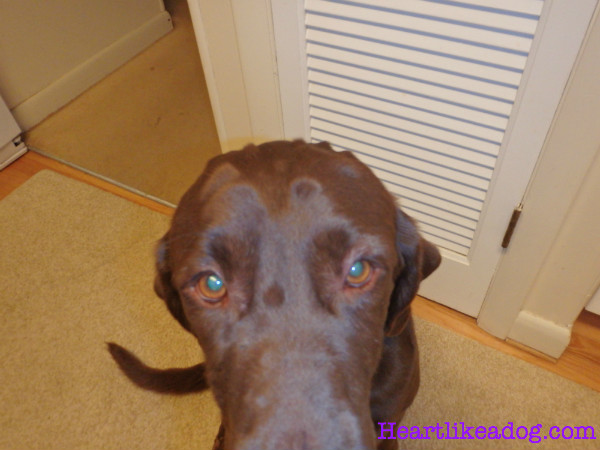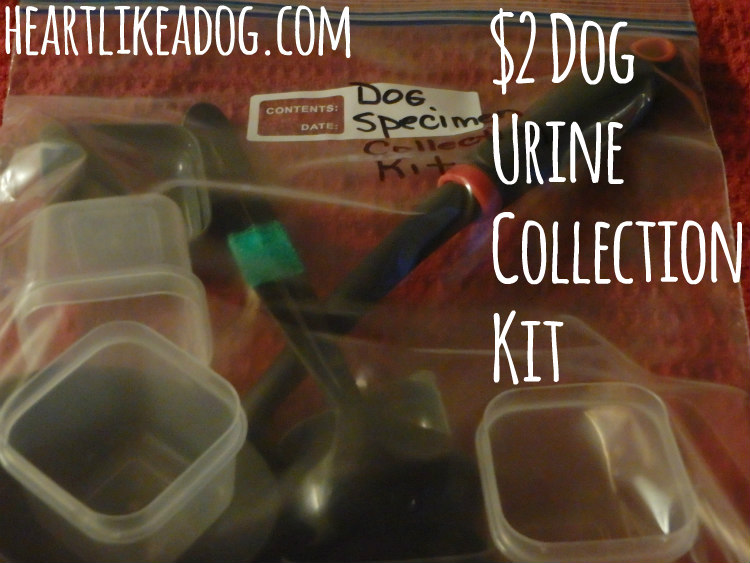When Delilah went to the vet’s for her annual check-up, I mentioned to Dr Soutter how I was concerned with Delilah’s inability to gain weight.
“I’m not worried about that at all!” Dr. Soutter exclaimed, “I’m more concerned with this ulcer in her eye!”
When Hubby and I looked, we were shocked to see a brown mark about 1/16th to 1/8th inch long in her right eye. While it was noticeable when pointed out to us, it wasn’t something we had noticed ourselves.
What is a Corneal Ulcer?
Think of the Cornea as a windshield for the eye. A Corneal Ulcer is an open sore on the Cornea. Naturally we were concerned about how she got it, and how to treat it. Dr. Soutter explained the majority of these eye ulcers occur due to an injury.
Anyone who has a Labrador Retriever knows, these guys do everything enthusiastically. This dog plows through gated areas in the house, dives under counters for a flake of tuna, disregards trees and shrubs in her path to run the fence line, and rides in the car with her head out the window.
For us, there was absolutely no way of knowing how, or when this injury had occurred.
Debridement of a Corneal Ulcer
Dr. Soutter said the way to treat the injury was to numb Delilah’s eye, and then ‘slough’ off the ulcer with a Q-tip. This is also known as “Debriding.” According to Wikipedia, Debridement is the medical removal of dead, damaged, or infected tissue to improve the healing potential of the remaining healthy tissue.” Source
I was freaked out about the idea of anything being put in her eye, but these ulcers can be painful, and we needed to begin the healing of her eye. Delilah tolerated the debridement quite well, and we were sent home with Tobramycin, an antibiotic drop that needed to be put in her eye four times a day.
FOUR TIMES A DAY.
She also needed a re-check in ten days to two weeks. I was faithful with the Tobramycin. Delilah absolutely hated it, but it had to be done. It is never fun when your dog shies away from you when you pull out that dropper.
We were also told that Delilah could be uncomfortable from the debridement, and if we noticed her rubbing the area, we would need to cone her. But she didn’t seem bothered in the least by it.
After two full weeks of antibiotic drops, FOUR TIMES A DAY, we headed back to the vet. It was so disappointing when Dr. Soutter said it wasn’t healing as well as she’d hoped, so at this point she recommended adding a serum twice per day, along with the antibiotic.
That’s drops in her eye six times per day, yo!
What is serum a.k.a. PRP?
I had never heard of serum for the eye. This serum is made from the blood of either a horse or a dog. It is put in the centrifuge and spun down, which isolates the platelets and blood plasma to separate from other components of the blood. The plasma and platelets are then combined into platelet-rich plasma a.k.a. PRP. (Which is in fact, a treatment all its own and is in experimental treatment for soft tissue injuries.) This serum has high concentrations of natural growth factors. In traditional PRP, the animals own blood is used, but in Delilah’s case, we were using serum made from the blood of a horse. (In retrospect, I would have insisted the serum be made from her own blood, but this was totally new to us, and I had no idea.)
The serum is contained in a sterile tube, and you use a syringe to remove the serum from the tube, then you take the needle off the syringe, and using the tube portion, put one drop of serum in the eye.
Dr. Soutter said there was a trick to it, but she didn’t tell me the trick. She did say you could put more in the syringe then you needed, so I filled that sucker up. (This, as I later found out, was NOT the way to do this.) The serum needed to be refrigerated, and I kept the full syringe standing up in one of the compartments on the door.
With Hubby holding her eye open, (you try holding open the eye of a dog that is not cooperating, and then depressing a plunger,) we managed to get a drop in the first night and the next morning. The next night, I shot the serum all over her face and the floor. It was all gone. $28 on my dog’s face and my kitchen floor. That ‘trick’ sure would have come in handy, before I wasted $28.
I was pissed. I called and asked for more, and asked if it could be in a bottle (it couldn’t, due to the sterility issue.) I was asked to come in so I could be shown ‘the trick.’
Here’s the trick, just in case you ever have to do this stuff yourself.
The trick is this…once you put the serum in the syringe, draw the plunger back slightly, and remove the needle. Now, when you gently depress the plunger, only a small drop comes out.
Delilah was on the serum for two weeks, at twice per day. Along with the Tobramycin four times per day. SIX TIMES PER DAY! SIX TIMES!
The kick is this, the drops have to be at least five minutes apart, because the eye can only absorb so much liquid. Also, I work. I’m gone from the house at least 9 1/2 hours per day. So she would get one antibiotic drop first thing in the morning, the serum when we got back from our walk, and another antibiotic drop just before I left for work. The evening schedule was one antibiotic drop as soon as I got home, the serum just before dinner, and another antibiotic drop at bedtime. It was challenging, but we made it work.
After the two weeks, Hubby and I both thought her eye looked better, and I took her back to see Dr. Soutter who said, “I think it’s time to see a ophthalmologist.” You could have knocked me over with a feather. Then she said, “Well, there’s one more thing I can try, I can take a needle and gently move the ulcer.”
I think my quick “NO” ticked her off a little, but I have a thing about eyes, and my thought was, if someone is sticking a needle in my dog’s eye, it will be someone who specializes in eyes.
Is there more than one antibiotic that can treat a Corneal Ulcer?
Dr. Soutter recommended two different ophthalmologists, one not too far from me, and one just over an hour away. I hemmed and hawed over which one, (it literally took me at least a week to decide) reading the reviews on YELP. (Side note. Don’t read the reviews. Happy people rarely write reviews.) While I made my decision, I researched Non-Healing Corneal Ulcers, and found there was more than one antibiotic used for treatment.
I had two thoughts…one being that as Delilah is an older dog, and I have learned from Sampson that everyone heals in their own way and time, maybe she just needed more time, or a different antibiotic drop. I asked Dr. Soutter if there was something else she could try while we waited for the ophthalmology appointment.
There was, and Dr. Soutter prescribed Neomycin-Polym which is a drug used in humans, and available at my local pharmacy. We also continued her on the serum.
Getting an appointment with a Canine Ophthalmologist is hard!
Finally I made my decision to take her to the ophthalmologist who was over an hour away. I was told that my vet would need to fax over her medical records, and the Dr. would determine the urgency with which she’d be seen. They called me the next day and said they could see her the following Wednesday. I was thrilled. Then she asked if I could drop her off in the morning and pick her up in the afternoon. The Vet tech would tell me what the Dr. thought when I picked her up.
NO…no.,..no! First, this tells me that my dog will sit in a crate all day, and the Dr. will see her when she has time. Two, I don’t know you, and more importantly, my dog doesn’t know you. I’m not comfortable with that. I was told if I needed an appointment they could not see me until August.
So I called the other facility, and it was basically the same spiel. My vet had to talk to the specialist, and then we could make an appointment. When I called them back after getting the go ahead from Dr. Soutter, I got the same deal. “Can you drop her off in the morning and pick her up in the afternoon?”
They got the same answer, “NO.”
I told them I needed an appointment, and thankfully, they had one in about ten days.
Dog or horse serum, does it make a difference?
In the meantime, we ran out of serum, and the vet’s office didn’t have any available, but one of the tech’s dogs was there, so they drew blood and spun us some dog serum.
This serum was pink compared to the yellowish serum I’d been getting, and quite frankly, it made me want to vomit every time I had to put it in her eye, but we did.
The day finally came for her appointment. Hubby and I had been thinking her eye looked great, and we were right! The ulcer had healed! (Hubs and I both really feel the dog serum made the difference for Delilah, although there is no documentation to back that theory up.)
After sharing the good news with me, Dr. Greenberg asked me if I’d noticed the blueish tinge Delilah has going on in her eyes.

It’s hard to photograph her eyes, but do you notice the blueish, or hazy effect that she has going on over her pupils?
I had noticed the color change, but I thought it was part of the natural eye aging process.
I was wrong. It’s actually a symptom of a progressive corneal disease.
Delilah was diagnosed with Endothelial Decompensation.
What is Endothelial Decompensation?
The inner layers of Delilah’s corneas have stopped functioning normally.
From her take home instructions: “The function of the inner layer of the cornea is to keep fluid out of it, helping to maintain its clarity. When the endothelium degenerates, fluid fills the cornea, which gives it a blue cloudy color. This is known as corneal edema. This fluid can form littler blisters or bullae, which can rupture and cause corneal ulceration.”
This is a life-long, progressive condition of which there is no cure. The goal will be to try and prevent blisters from forming in her eyes, and turning into ulcers and to keep her eyes comfortable.
It’s very likely Delilah’s ulcer was from the disease, and not an injury as we had originally suspected.
According to the paperwork, most dogs maintain functional vision with this condition.
The best thing we can do for Delilah, is to have regular visits to the ophthalmologist, and keep looking into those beautiful eyes to make sure she doesn’t have an ulcer.








Recent Comments